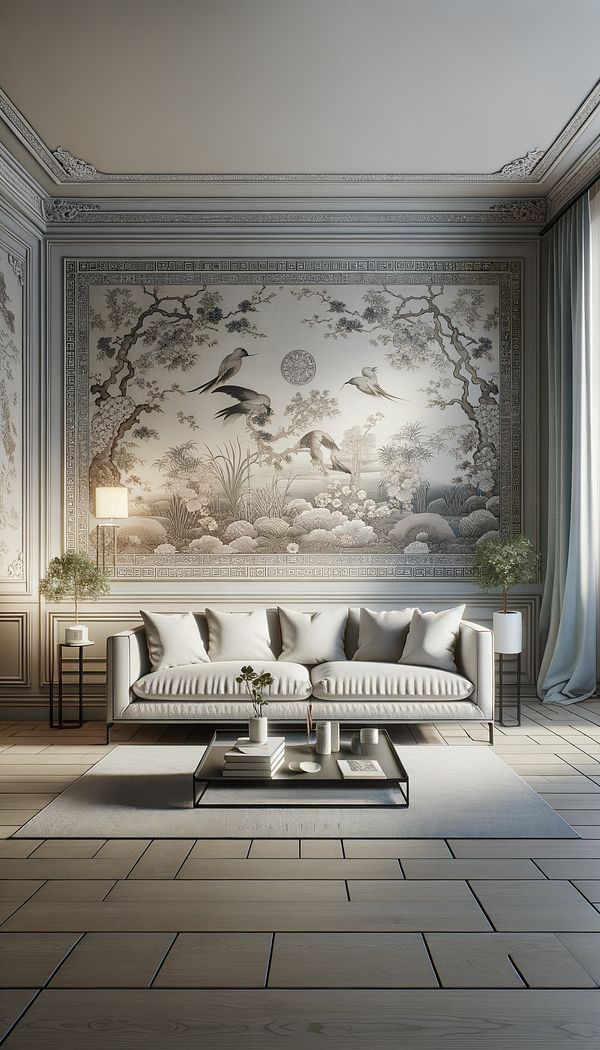What is Chinoiserie?
Chinoiserie is a style inspired by Chinese artistic influences.
Description
Chinoiserie, a term derived from the French word 'chinois,' meaning 'Chinese,' is a unique style that emerged in the 17th and 18th centuries in Europe. This decorative genre is characterized by its use of motifs, patterns, and themes from Chinese art and culture, often incorporating them into Western designs. The fascination with the East, combined with the limited accessibility of Asian goods at the time, led to an imaginative and romanticized interpretation of Chinese aesthetics by European craftsmen and artists.
Chinoiserie encompasses a wide range of decorative elements, from furniture and porcelain to wallpapers and fabrics. It is notable for its intricate designs, exotic landscapes, and vivid depictions of dragons, pagodas, and other traditional Chinese motifs. The use of bold colors, particularly blue and white, as well as gold accents, is common in chinoiserie pieces. This style bridges the gap between Eastern and Western design principles, bringing an exotic flair to interior spaces.
Over time, chinoiserie has evolved but continues to be a popular choice for adding an elegant and whimsical touch to interiors. Its adaptability and timeless appeal have ensured its presence in modern designs, where it is often blended with contemporary elements to create eclectic, sophisticated spaces.
Usage
In interior design, chinoiserie can be found in various applications, ranging from intricately painted furniture and handcrafted porcelain vases to wallpaper adorned with scenes reminiscent of Chinese landscapes. This style is often used in dining rooms, living spaces, and bedrooms to introduce an element of luxury and exotism. Designers may also incorporate chinoiserie patterns in textiles, such as cushions and curtains, to add a subtle touch of the style to an interior.
FAQs
-
Is chinoiserie considered culturally appropriate?
Chinoiserie is deeply rooted in a historical context of cultural exchange and admiration. While it originated from a European interpretation of Chinese art, understanding its background and appreciating it as a form of artistic expression can mitigate concerns of cultural appropriation. It's essential to approach chinoiserie with respect and sensitivity towards its cultural origins.
-
Can chinoiserie be incorporated into modern interiors?
Absolutely. Chinoiserie's versatile and timeless nature allows it to blend beautifully with modern design elements. Incorporating chinoiserie into a contemporary space can add depth, visual interest, and a touch of history. The key is to balance its intricate patterns and vibrant motifs with the sleek lines and simplicity inherent in modern design.
-
How do I identify authentic chinoiserie pieces?
Authentic chinoiserie pieces often feature detailed craftsmanship, traditional Chinese motifs such as dragons and pagodas, and a palette that includes blue and white or vibrant colors with gold accents. Antique pieces may show signs of age but should still exhibit quality craftsmanship. For contemporary chinoiserie, look for items that respect the traditional patterns and motifs associated with the style.
Practical Application
To incorporate chinoiserie into your interior design, start by selecting one or two statement pieces, such as a painted cabinet or a porcelain vase, as focal points in your space. Complement these with smaller decorative items like cushions or wall art that echo the chinoiserie motifs. Keep the backdrop simple to allow the intricate designs to stand out. Remember, a little goes a long way with chinoiserie, so use it thoughtfully to create an elegant and cohesive look.
-
Design Styles478 articles
-
Furniture Types599 articles
-
Decorative Objects240 articles
-
Wall & Ceiling Treatments35 articles
-
Textiles & Upholstery252 articles
-
Egyptian CottonEgyptian Cotton is a luxurious type of cotton known for its long fibers.
-
Trumpet LegA trumpet leg is a type of furniture leg, characterized by its flared shape that resembles a trumpet.
-
CassoneA large wooden chest, often richly decorated, used historically in Italy for storage and as a dowry trunk.
-
Window TreatmentWindow treatment refers to the decoration and functionality added to windows.
-
PillingPilling is the formation of small, fuzzy balls on the surface of a fabric due to wear or friction.
